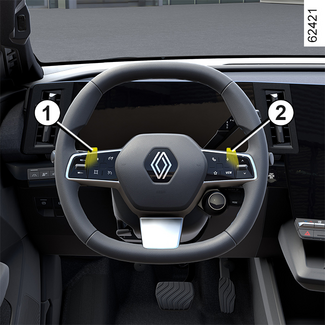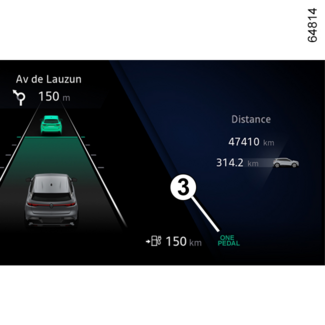Regenerative braking system
Regenerative braking system
By releasing the accelerator, the vehicle uses regenerative braking to slow down the
vehicle.
Some of this energy is converted to electricity to recharge the traction battery.
The paddles behind the steering wheel can be used to increase or decrease regenerative
braking.
WARNING
The regenerative braking should under no circumstances be used as a substitute for
the brake pedal.
Regenerative braking change paddles 1 and 2

Depending on the vehicle, paddles 1 and 2 can be used to change the regenerative braking level when the gear lever is in position
D.
1: increase regenerative braking.
2: decrease regenerative braking.
The paddles can only be operated when the gear lever is in D position. It is not possible to use the paddles while adaptive cruise control is
activated STOP AND GO ADAPTIVE CRUISE CONTROL.
Driving with paddles


Regenerative braking levels
The 3 warning light informs you of the regenerative braking level:
- A: "Free-wheel" level for gentle, economical driving. Requires driving with anticipation;
- B: low regenerative braking level;
- C: average regenerative braking level;
- D: high regenerative braking level;
- E: (depending on vehicle) maximum regenerative braking level and One Pedal function activated.
One Pedal function
On equipped vehicles, the One Pedal function facilitates driving in built-up areas
or heavy traffic, mainly by using the accelerator pedal.
When you release the accelerator pedal sufficiently, the vehicle decelerates until
it comes to a complete stop.
When you release the accelerator pedal completely, the regenerative braking level
is at its maximum.
Press the accelerator pedal sufficiently to regain speed.
Activation


With the lever in position D, press the paddle 1 as many times as necessary until the "One Pedal activated" message appears. The ONE
PEDAL 3 warning light appears, accompanied by a beep, to confirm that it is activated.
Tip
The One Pedal function does not make an emergency stop and its braking performance
is limited.
WARNING
This function is an additional driving aid. This function is not under any circumstances
intended to replace the due care and attention of the driver, who should at all times
be in control of the vehicle.
Note: with One Pedal activated, the vehicle stationary and lever in position D, the vehicle will not move when you release the brake pedal.
Put on standby
When reverse gear is selected, the function goes on standby. The ONE PEDAL warning
light is displayed in grey on the instrument panel.
The function reactivates in D position beyond a certain speed threshold. The ONE PEDAL warning light appears in
green to confirm reactivation.
Note: the parking brake is applied automatically when the vehicle remains stationary for
more than approximately two minutes.
Deactivation
To deactivate the function:
- while driving, press the paddle 2;
- when stationary, press the brake pedal and then the paddle 2.
Thee "One Pedal deactivated" message appears on the instrument panel. The ONE PEDAL
warning light 3 disappears, accompanied by a beep, to confirm deactivation.
The function deactivates automatically when the engine stops.
Limits of operation
- On low grip surfaces (frost, snow, etc.), the function may be subject to excessive deceleration in which case it is advisable to use braking levels A, B, C or DDRIVING WITH PADDLES;
- In the case of a steep slope, with the accelerator pedal released, the One Pedal function may not be sufficient to keep the vehicle stationary. Make sure the vehicle is stationary by pressing the brake pedal, activating the electronic parking brake or, depending on the vehicle, the handbrake.
Operating faults
When the system detects a malfunction, the "One Pedal unavailable" message informs
you that it is unavailable. Consult an approved dealer.